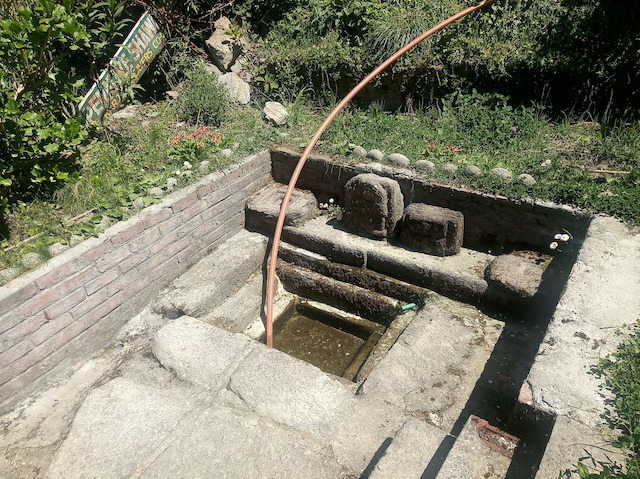Manali, April 18, 2021: Himachal Pradesh Natural Resource Management Society with the aid from World Bank is aiming Natural Resource Management, watershed protection and development in the State of Himachal Pradesh
Vinay Kumar, a hydrologist wsays that the mission of the society is to improve upstream watershed management and increase agricultural water productivity in 856 buries of Gram Panchayats in Himachal Pradesh.
He added that the Project has become operative in 10 districts of Himachal Pradesh with the financial assistance of the World Bank. The Project builds on the successful experience of the HP Mid Himalayan Watershed Development Project (HPMHWDP) IDP Project aims to improve upstream watershed management and increase agricultural water productivity in selected Gram Panchayats in Himachal Pradesh.
Vinay explained that the spring is formed when natural pressure forces groundwater above the land surface. This can occur at a distinct point or over a large seepage area. Springs are sometimes used as water supplies and can be a reliable and relatively inexpensive source of drinking water if they are developed and maintained.
He added since springs are usually fed by shallow groundwater, water quantity may be an issue during certain times of the year. If possible, the flow rate for your spring should be monitored for an entire year, but it is most critical to measure the flow rate during late summer and fall when groundwater levels and spring flows are usually at their lowest. Springs used for drinking water supplies should yield at least 2 gallons per minute throughout the entire year unless water storage is going to be used. The amount of water you will need from your spring depends entirely on your household’s daily water needs.

Vinay Kumar said that out of 20700 villages 2597 have spring water sources. He added that perennial discharge is getting reduced day by day. Erratic rainfall, seismic activity and ecological degradation of forest catchments are impacting the mountain aquifer system affecting life and livelihood at large people living in middle and lower altitudes. He added that the situation is predicted to worsen with changing climatic conditions and rainfall patterns. The shortage of drinking water is getting more acute day by day.
Therefore, there is an urgent need to rehabilitate the depleting natural traditional water sources i.e. the springs. Under this activity civil structure if existing spring sources will be renovated.
He added that under the project in each Gram panchayat two buries (spring) will be treated. So in total 1284 such bauries will be renovated for effective use of spring water for various domestic, livestock and even to some extent the agriculture uses.
The Himalayas are the largest and tallest mountain range in the world, spanning 8 countries viz., Afghanistan, Pakistan, China, India, Nepal, Bhutan, Bangladesh, and Myanmar and covering an area of about 43 lakh km2. Nine major perennial rivers viz., Indus, Ganges, Brahmaputra, Irrawaddy, Salween, Mekong, Tarim, Yangtse and Yellow River have their origins in the Himalayas.
More than 30 peaks of the Himalayas rise to heights of 7,620 m (25,000 ft) or more, including Mount Everest (8,848 m), the world’s highest mountain. Nearly 1.5 billion people depend on the Himalayas for water, food and energy. Mountain springs are the primary source of water for rural households in the Himalayan region. For many people, springs are the sole source of water.
A major proportion of the drinking water supply in the mountainous parts of Himachal are spring-based, while villages in the State use springs for drinking, irrigation and for livestock. Despite the key role that they play, springs have not received their due attention and many are drying up. Spring discharge is reported to be declining due to increased water demand, land-use change, and ecological degradation.
With climate change and rising temperatures, rise in rainfall intensity and reduction in its temporal spread, and a marked decline in winter rain, the problem of dying springs is being increasingly felt across the Indian Himalayan Region. Even effects are being observed in nearly all the mountainous regions of India. Besides, water quality is also deteriorating under changing land use and improper sanitation.
A few State governments, Civil Society Organizations (CSOs) and Non-Governmental Organisations (NGOs) are actively contributing towards programmes to promote awareness of the importance of springs, and to build capacities to protect, develop and manage “spring sheds” across the country. At the community level, most spring protection efforts have a similar programmatic approach: mapping of spring sheds through hydrogeology; restoration, protection and/or augmentation of recharge; monitoring and management of springs; and, dissemination, outreach and sharing of knowledge.
The success of spring restoration and of the Springs Initiative hinges on the enthusiastic participation of all the entities concerned. Firstly, there are the communities that use springs. It is important that they are convinced of the need to conserve their springs, understand how it is done, and are willing to assume responsibility for managing their springs. In most cases, therefore, the demand for spring restoration needs to come from such communities. The crises surrounding water necessitates that spring water management be taken up at the regional scale.
Moreover, there is also an urgent need to take up a national-level initiative focused on rejuvenation, restoration and management of Himalayan springs. In order to bring the issue of spring shed management to centre stage in the context of sustainable development in the Indian Himalayan Region, Himachal Pradesh Natural Resource Management Society.

Sanjay Dutta, an engineer by qualification but is a journalist by choice.
He has worked for the premier new agency Press Trust of India and leading English daily Indian Express.
With more than a decade of experience, he has been highlighting issues related to environment, tourism and other aspects affecting mountain ecology.
Sanjay Dutta lives in a village close to Manali in Kullu valley of Himachal.


